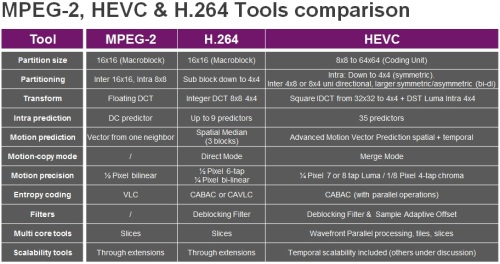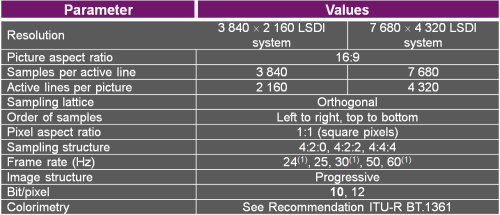Next-Generation Video Transcoding

Fig. 3: MPEG-2, H.264 and HEVC/H.265 tools comparison
Today, designing a video coding standard for both mobile and consumer devices is primarily aimed at achieving the highest coding efficiency possible. This translates into an ability to encode or decode video at the lowest possible bitrate while maintaining a defined level of video quality.
Several studies have compared the coding efficiency of the H.265 Main Profile (MP) to similar profiles from several existing video standards in use today, including H.264, MPEG-4 AVC, H.263, and H.262. These comparisons usually involve video encoding done for a range of application use-cases (live entertainment, video conferencing, films, etc.) and different bitrates corresponding to certain video test sequences. So far, HEVC has been shown to deliver superior bitrate reductions based on both objective (PSNR, SSIM, etc.) and subjective evaluations, making it ideal for delivering high quality video at low bitrates.
Opportunities and challenges for H.265
Perhaps the key takeaway when thinking about H.265 is that simply using it for video compression does not guarantee quality. Indeed the quality of HEVC video is determined by how complex and feature-rich the encoder is.
In fact, using a sub-optimal software-based solution or a low-quality HEVC encoder can lead to worse results than today’s best H.264 solutions. Encoder quality dependencies include the motion search algorithm and range, tool set implementation and rate control algorithm.
One of the more interesting debates at the moment is around GPU compute-based HEVC software transcoding. These solutions are a reasonable first step towards implementing some
relevant use cases for existing platforms that do not have dedicated hardware; HEVC at 1080p is one of a few examples. However, hardware video trans coding brings significant advantages and
features (10-bit color, YCbCr 4:4:4 resolutions, etc.) so ultimately most platforms will include hardware video codecs.
The combination of HEVC, 4K resolutions and the desire for higher frame rates means a core’s power consumption is critical. If not designed carefully, such a core might drive the overall system power consumption to extremes. Independent tests, for example, have shown that PowerVR video processors (VPUs) are not only lower power but much faster at transcoding video streams. A recent example from Anandtech, shown in Figure 3, compares a number of existing platforms encoding a standard video stream.

Fig. 4: Imagination’s PowerVR video core enables Intel Clover Trail processor to deliver better performance, lower power and faster transcode.



















